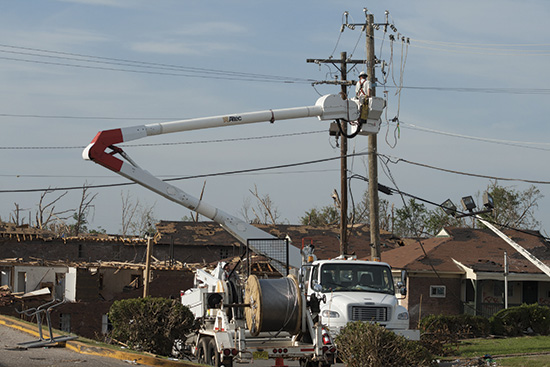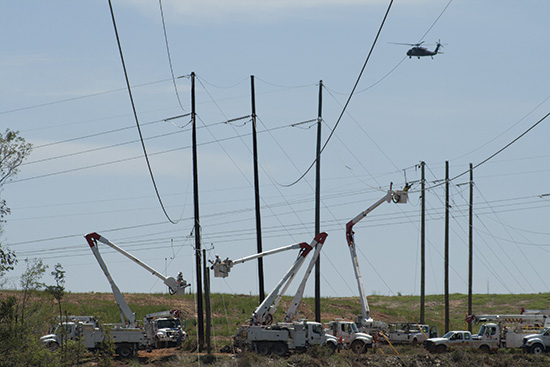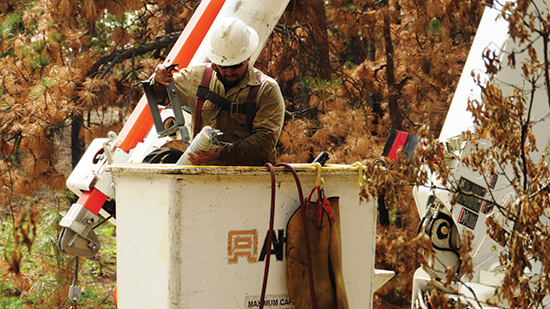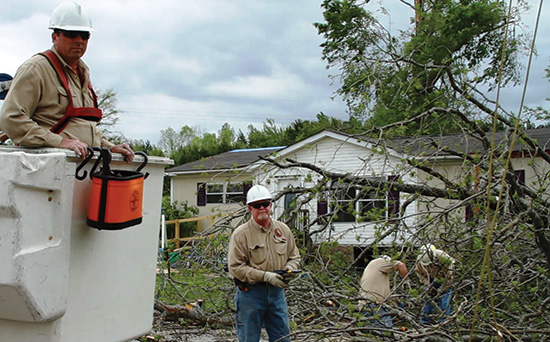For the contactors, utilities, and cooperatives who use them, the platform of a bucket truck is likely to be associated with helping customers. In times of disasters – from the string of tornadoes in 2011, to the Northeast superstorm, to hurricanes and more – those trucks and the people who work from them represent hope and recovery. And that process is never simple, never easy.
Bringing restoration to thousands – or millions – requires expertise, experience and knowledge, something that the hundreds of people who use specialized products have learned over the years. While the winds are calm and weather gentle, now is the time to consider the perspective of experts, those who have learned from dealing directly with disaster.
Communication
Often when thinking of communication, the focus is on what happens during an event, and it should be. But just as important may be developing some strong relationships and communication practices beforehand.
During the string of tornadoes in April 2011, cellular towers located throughout portions of north central Alabama were destroyed, making cell phone reception impossible or, at best, challenging. Coordinating efforts or even getting maintenance parts and equipment to where it was needed was difficult.

As crews worked to restore power, dedicated representatives were at a staging area at the Birmingham-Jefferson Civic Center, sourcing repair parts, diagnosing issues and providing on-site, on-time help. Several times a day, these representatives would meet with various foremen, who would let them know what was needed – replacement parts or repairs – and from there, techs could coordinate and find the parts needed to keep crews working.
“With cell service disrupted, crews had to rely on other things: CBs, two-way radios and word of mouth,” said Brent Bridier, Service Representative. ”What became important was having specific meeting places and locations to get supplies and help, and pre-planned processes for delivery.”
With 16-hour days, contractor and utility crews providing recovery assistance were sheltered, organized and given assignments for the next day. Many of these crews were from out-of-state, so maximizing what was learned and needed in a short span of time was crucial, as was planning beforehand by the utilities to cooperate in restoration. If parts needed to be ordered, they were sourced from a nearby facility or ordered from Altec Parts Central Distribution, then delivered directly to the crew’s work sites.
Cleveland Utilities, which services Cleveland and Bradley counties out of eastern Tennessee, is an active member of the Tennessee Valley Public Power Association (TVPPA). Associations like the TVPPA coordinate mutual aid recovery during natural disasters such as the tornadoes of 2011.
“With a 15-truck fleet and 60 percent of our customers without power after the tornadoes, we had no choice but to rely on aid from other utilities,” said Bart Borden, Cleveland Electric Utilities Division Vice President. “Through the coordination of the TVPPA, we were able to easily source available crews throughout the southeast and have since returned the favor to some of the crews who helped us during that time.”

And according to Borden, being prepared includes knowing who to turn to in recovery: “When crews come in to help, we always send someone who knows our systems with them – not linemen but meter readers, installers, etc. And if the event is large enough, we’ll ask for help from retired linemen who know our practices and have been such a huge asset to us in the past.”
“Having someone who you already trust ready to help, that’s the best communication preparation possible,” said Todd Neil, Global National Sales Manager. “The best way to prepare before disaster is to develop relationships with contacts before you need them. Know numbers, names and faces associated with your equipment, service and parts dealers. Know where your help will come from.”
Rentals
The utility equipment rental market is dynamic. Available equipment changes by the minute, especially during times of natural disaster. With the cost of equipment on the rise and the ongoing upgrades to the electric grid system, the market has seen an increase in rental demand.
Securing rental equipment before it is needed is critical. Immediately following a natural disaster, affected Altec customers receive a list of available rental equipment and can reserve what they need depending on the size and scope of the event. Other providers typically provide similar lists.
However, at that point, the demand is high and the supply fluctuates. “When it comes to securing equipment during a disaster, it’s best to commit as early as possible,” said Neil.
Contract terms are important to understand when making the decision to invest in rental equipment. When a recovery period is uncertain and a rental company charges based on a minimum term, the customer is then faced with making the decision to pay for a predetermined length of time without knowing how long they will need to use it.
Fleet managers often make the decision to use older, owned equipment for disaster recovery. The practice of utilizing older units to use during long hours of maximum capacity work load can be unreliable and cost the business in the long run. Recently serviced and inspected units that crew members are familiar with operating serve as the best trucks to have for recovery.
Equipment rental vendors will often work with companies to develop a customized rent/purchase program, which ensures the utility will have rental equipment available during hurricane season. These programs add extra equipment to the fleet purchase for the following year, but the extra ‘storm pool’ units are delivered before next year’s delivery date. The utility pays the monthly rental fee for the availability of the equipment, but receives rental credit toward the purchase of the storm pool units on the following year’s budget.
“Having a built-in insurance policy of storm recovery units, built to a utility’s specification, that can be used in the event of a hurricane is wise,” said Neil. “And having the pre-existing relationship is also beneficial to the customer.”
Keeping Trucks Moving
One thing that is true of any disaster is to expect the unexpected. Equipment will need maintenance; parts will be required and service techs will be in high demand.

“The best parts to have on hand for any emergency are common preventative maintenance and wear items,” said Parts Representative, Matt Kennedy. “Digger derricks or material handling aerial units heading into a disaster area are much more effective with spare load lines.”
From lifting transformers on a material handling aerial to placing poles on a digger derrick, load lines take a lot of wear and tear during disaster recovery. The common, yet incorrect, practice of ‘flipping’ a damaged load line on the drum can potentially lead to a major problem. Extra hydraulic fluid and filters as well as hydraulic hose and seal repair kits with field fittings that don’t require crimping can handle on-site hydraulic leaks. Keep these parts available in a mobile parts and supply trailer that can be accessed from a central staging location.
Southern California Edison (SCE) provided mutual aid during Superstorm Sandy of 2012. Jim Wood of SCE Construction Methods team utilized two mobile service trucks equipped with a manager and two trained mechanics each, stocked with preventative maintenance parts, as well as equipment like portable welders and lubricant.

“My one regret is not bringing our own supply trailers,” said Wood. “The utilities underestimated the amount of supplies they would need to distribute to recovery crews, so our guys had to wait on extra supplies like power poles and other line materials. Even if the trailer is never used, the amount of time you won’t waste waiting for supplies is worth it.”
Foothills Energy Services (FES) provided assistance to Mountain View Electric Association during the Colorado Black Forest Fires of 2013. An unprecedented event for that area, the crews worked 15 hour days for six weeks. President of FES, Steve Marr, now keeps extra flame retardant clothing on hand as well as air filters. Covered in soot and ash, the air filters needed to be changed once a day.
On the ground and on to recovery
Sometimes, the lesson learned from a disaster is that having the right equipment or staffing makes all the difference. Bart Borden, Cleveland Utilities, added an Altec A77T following the devastating tornadoes of 2011. The utility assigned mutual aid workers to replace the 250 distribution poles that were down, while the city of Cleveland assigned their crews to restore their damaged 69 kilovolt transmission system.
“The 2,000 pound jib and the working height on the A77T would’ve been extremely useful to reach our 75 to 90 foot transmission poles,” remarked Borden. “If we had that truck during the tornado recovery, we could have accomplished a dayand- a-half of work in about six hours.”
Cleveland Utilities also invested in a collapsible reel to extend off the shaft of their front winch on the A77T. Instead of spending hours manually coiling damaged power lines, the collapsible reel is a cost effective way to maximize the productivity of a front winch on utility vehicles.
From trucks to people, mobilizing enough crew members can also make a difference. From his experience with Superstorm Sandy, Wood, Southern California Edison, recommends adding an additional crew member to each vehicle to ensure a safer, more productive recovery effort. Now, they send one digger derrick for every three aerial devices with one foreman, two linemen and one groundsman.
And while the focus during a crisis may be on restoring utilities and serving the needs of the community, making sure that the people who are doing the work of restoration are taken care of is just as important.
“Safety items,” said Tony Gaede, The company’s Supply Manager. “Ground flags, safety signs and stands, lights and rainwear… and personal voltage detectors, such as V-Watch. Customers need to have plenty of these and make sure they are in good working condition.”
“The relationship between vendors and local utilities really shines in these times,” said Dwight Johnson, Mobile Service Technician. “Providing a common point of reference for contractors – like a website set up by utilities – can help source assistance and supplies, from local vendors, to hotels, fueling locations and more.”
In the end, the purpose of being prepared is to make the restoration quicker and safer. The point of planning ahead is to remove minutes, when minutes count. It’s people who work the lines, trucks and poles when the work of restoration begins. And it’s the people who ultimately make a difference.
“We can talk about trucks and maintenance and restoration, but the most important thing all of us can do is provide the safest, most efficient recovery environment possible, so the real heroes can get out there and do their jobs,” noted Gaede.
About the Author
 Jason Tower has been in the utility equipment manufacturing industry for 12 years and currently serves as Altec Service Group Market Manager. His focus is to expand the company’s service foot print through determining marketing segments and market share in order to shape strategy for continuous growth.
Jason Tower has been in the utility equipment manufacturing industry for 12 years and currently serves as Altec Service Group Market Manager. His focus is to expand the company’s service foot print through determining marketing segments and market share in order to shape strategy for continuous growth.







